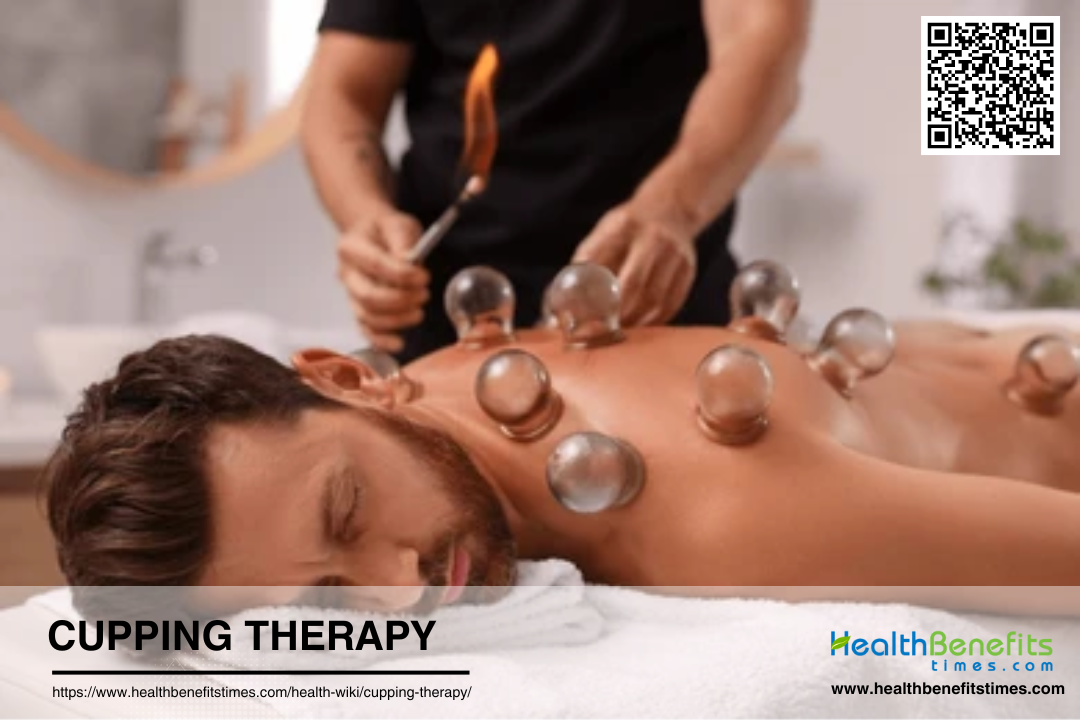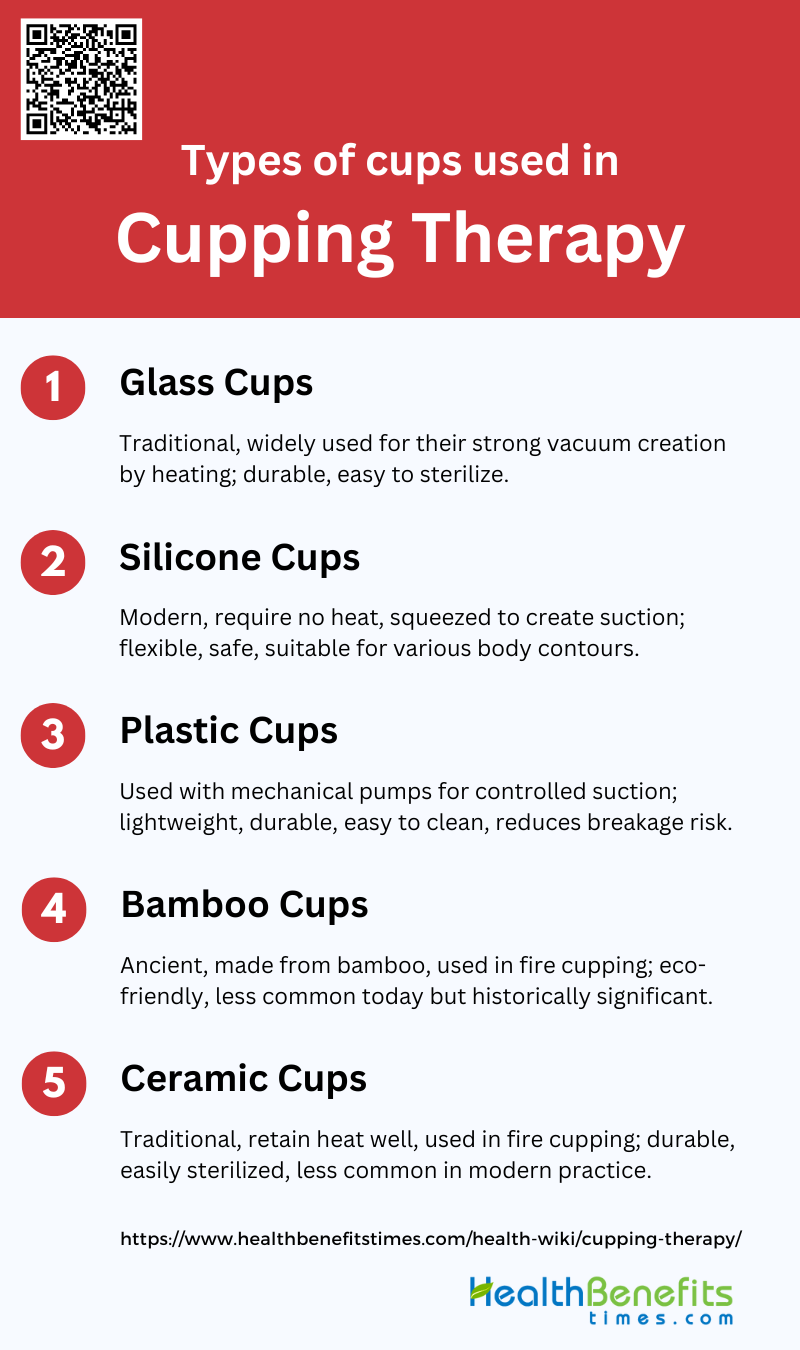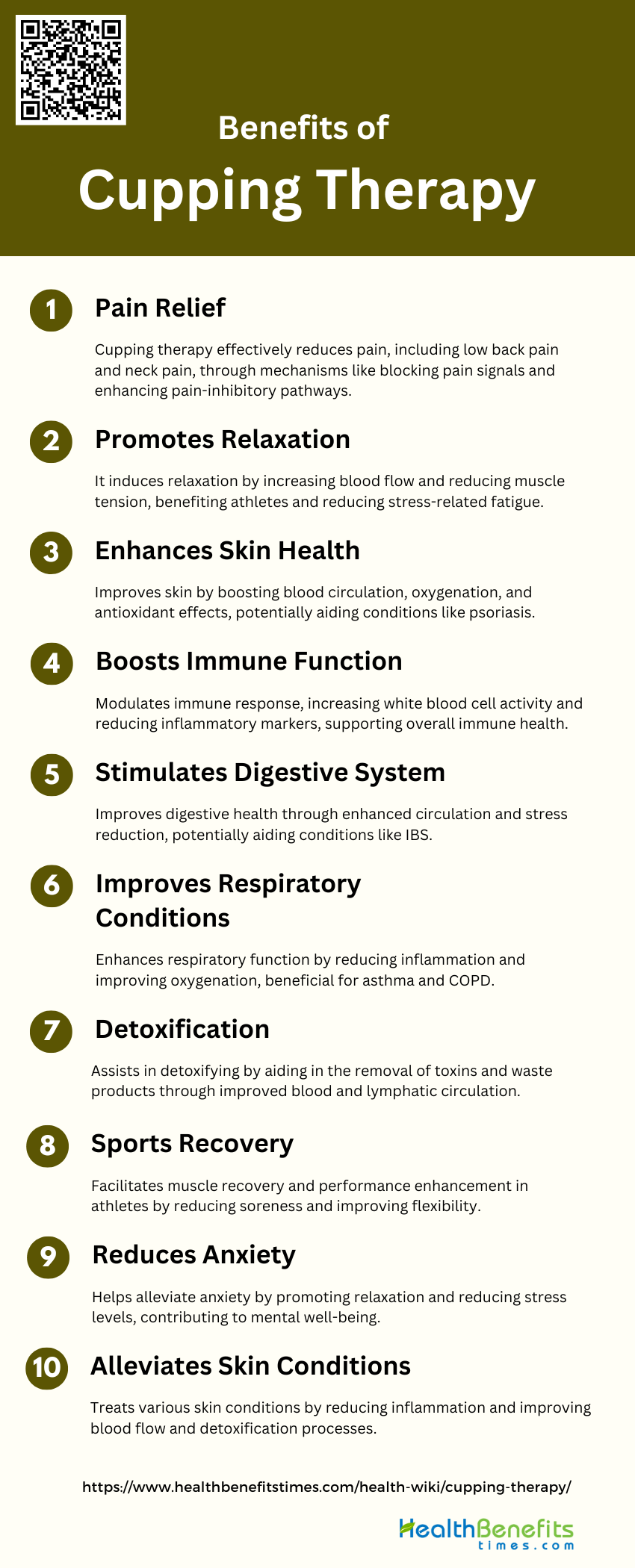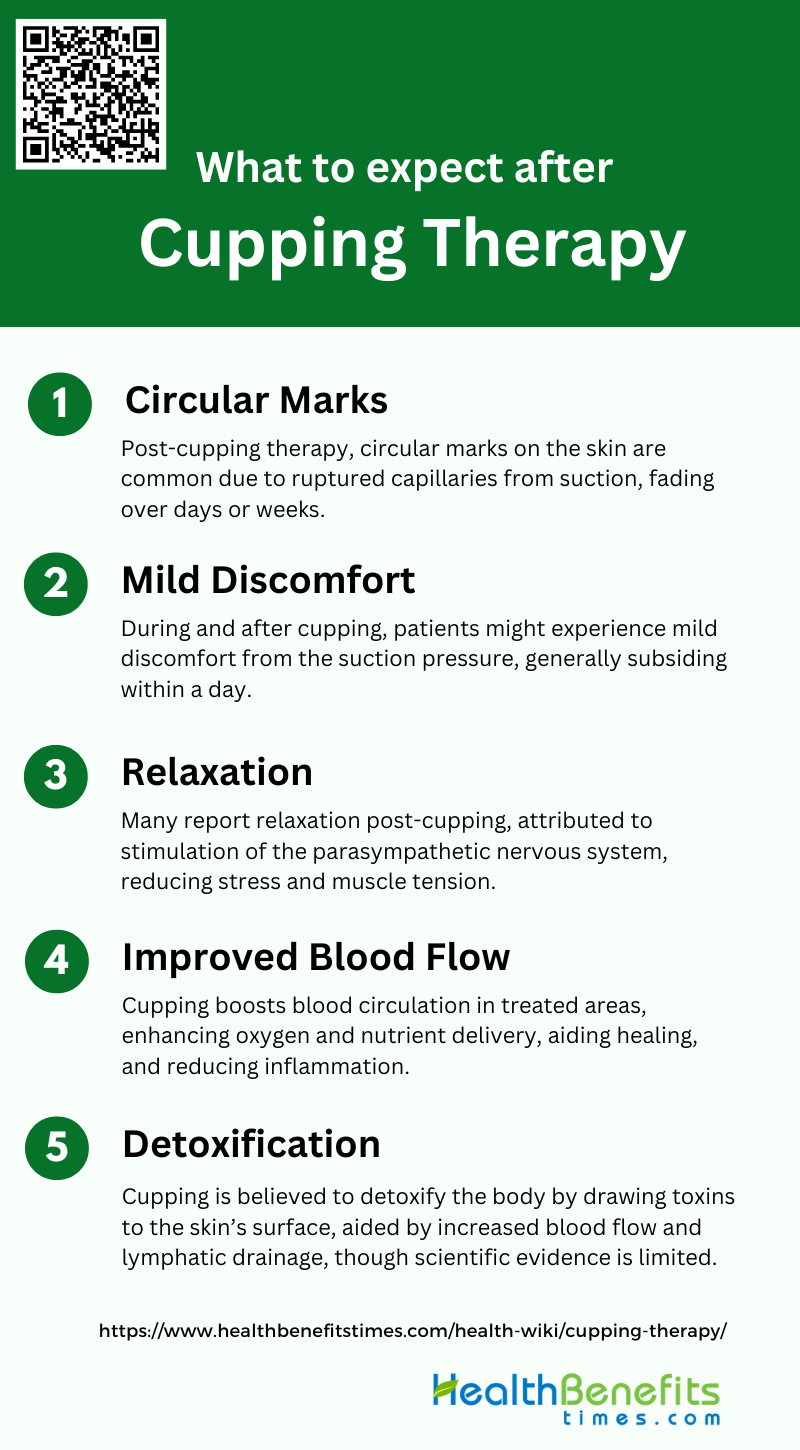Cupping therapy is an ancient therapeutic practice that involves placing cups on the skin to create suction, which is believed to promote healing and alleviate various health conditions. This therapy can be categorized into two main types: dry cupping, which involves suction only, and wet cupping, which includes controlled incisions to draw out blood. The suction is typically created using heat or mechanical devices, and the therapy is thought to improve blood circulation, reduce inflammation, and enhance overall well-being. Cupping has been used to treat a range of conditions, including musculoskeletal pain, respiratory issues, and even mental health disorders. Despite its long history and widespread use in traditional and complementary medicine systems, the exact mechanisms behind its therapeutic effects remain a topic of ongoing research and debate within the medical community.
How Cupping Therapy Works?
This suction causes the skin and underlying tissues to be drawn into the cup, leading to increased blood flow and stretching of the tissues. The mechanical effects of cupping result in capillary dilation and rupture, which stimulates the production of heme oxygenase-1 (HO-1) and its byproducts, such as carbon monoxide, biliverdin, and bilirubin. These substances have been shown to possess antioxidant, anti-inflammatory, and neuromodulatory properties, potentially explaining the local and systemic health benefits of cupping therapy. Clinical studies have demonstrated its efficacy in treating various conditions, including herpes zoster, facial paralysis, acne, cervical spondylosis, and musculoskeletal pain. Additionally, cupping therapy has shown promise in improving symptoms of carpal tunnel syndrome and increasing blood oxygen levels, further supporting its therapeutic potential. However, the quality of evidence varies, and more rigorously designed trials are needed to fully understand its mechanisms and effectiveness.
Description of the process of Cupping Therapy
The process involves placing cups on the skin to create suction, which is believed to promote healing and alleviate pain. There are different techniques of cupping, including dry cupping, wet cupping, moving cupping, and flash cupping. Wet cupping involves making small incisions on the skin before applying the cups to draw out a small amount of blood, which is thought to remove toxins and improve circulation. The suction created by the cups causes the skin and underlying tissues to be drawn into the cup, leading to increased blood flow, stretching of the tissues, and potential capillary rupture, which can result in localized bruising. This mechanical effect is believed to stimulate the production of beneficial substances such as Heme Oxygenase-1, which has antioxidant and anti-inflammatory properties. Cupping therapy has been applied to treat various conditions, including musculoskeletal pain, skin diseases, and respiratory issues, with some studies suggesting potential benefits, although the evidence is often of low methodological quality and further rigorous research is needed.
Types of cupping techniques
This therapy involves several techniques, each with its own unique approach and benefits. Here are some common types of cupping techniques:
1. Dry Cupping (Static Cupping): This is the most common form of cupping. Cups are placed on the skin and suction is created, but the cups are not moved. They are left in place for a set period, usually between 5 to 15 minutes.
2. Wet Cupping (Hijama): This technique involves making small incisions on the skin after cups have been applied and suction has drawn the blood to the surface. This is thought to remove harmful substances and toxins from the body.
3. Moving Cupping (Gliding Cupping): In this method, oil is applied to the skin before placing the cups. The cups are then moved across the skin, maintaining suction. This is similar to a massage and is used to target larger areas of muscle and tissue.
4. Fire Cupping: This traditional technique involves soaking a cotton ball in alcohol and then lighting it on fire inside the cup to remove the oxygen and create a vacuum as it cools. The cup is then quickly placed onto the skin. This method is believed to enhance the suction effect.
5. Flash Cupping: Flash cupping involves repeatedly applying and removing the cup quickly. This technique is less intense and can be used for sensitive skin or areas where prolonged suction might be painful.
6. Needle Cupping: In this method, acupuncture needles are inserted into the skin before the cup is applied over the site. This combines the benefits of both acupuncture and cupping.
7. Herbal Cupping: This involves placing herbs in the cups before heating them. The heat causes the herbs to release their oils and essences, which are believed to penetrate the skin and help with healing.
8. Magnetic Cupping: This technique uses cups that have a magnetic setting, which is thought to add the benefits of magnetic therapy to traditional cupping effects.
Types of Cups Used in Cupping Therapy
In cupping therapy, various types of cups are used, each with its own unique properties and applications. Here are some common types of cups used in cupping therapy:
1. Glass Cups
Glass cups are one of the most traditional and widely used types in cupping therapy. They are favored for their ability to create a strong vacuum when heated, which is essential for effective treatment. The process involves heating the air inside the glass cup and then placing it on the skin, creating a suction effect as the air cools and contracts. This method has been used historically to increase blood circulation and promote healing in specific areas of the body. Glass cups are known for their durability and ease of sterilization, making them a popular choice in both historical and modern practices of cupping therapy.
2. Silicone Cups
Silicone cups are a modern adaptation in the practice of cupping therapy. Unlike glass cups, silicone cups do not require heating to create suction. Instead, they are squeezed to expel air and then placed on the skin, where they create a vacuum as they return to their original shape. This makes them safer and easier to use, especially for self-application. Silicone cups are flexible and can be used on various body contours, making them versatile for different treatment areas. They are also less likely to cause burns or other injuries, which can be a risk with heated glass cups.
3. Plastic Cups
Plastic cups are another contemporary option in cupping therapy, often used in conjunction with a mechanical pump to create suction. This method allows for precise control over the amount of suction applied, which can be beneficial for treating different conditions and patient sensitivities. Plastic cups are lightweight, durable, and easy to clean, making them a practical choice for both practitioners and patients. They are also less fragile than glass cups, reducing the risk of breakage and injury. The use of plastic cups has become increasingly popular due to their convenience and effectiveness in modern cupping practices.
4. Bamboo Cups
Bamboo cups are one of the oldest types of cups used in cupping therapy, particularly in traditional Chinese medicine. These cups are made from hollowed-out bamboo segments and are known for their natural and eco-friendly properties. Bamboo cups are typically used in fire cupping, where a flame is briefly introduced inside the cup to create a vacuum before placing it on the skin. This method is believed to help in balancing the body’s energy and improving blood circulation. Although less common in modern practice, bamboo cups are still valued for their historical significance and natural appeal.
5. Ceramic Cups
Ceramic cups are another traditional type of cup used in cupping therapy, particularly in regions where ceramic materials were readily available. These cups are known for their smooth surface and ability to retain heat, which can enhance the therapeutic effects of cupping. Like glass cups, ceramic cups are typically used in fire cupping, where they are heated to create a vacuum. Ceramic cups are durable and can be easily sterilized, making them a hygienic option for cupping therapy. Their use, however, is less common today compared to glass and silicone cups, but they remain an important part of the historical practice of cupping.
Benefits of Cupping Therapy
Cupping therapy offers a variety of benefits, which can vary depending on the individual and the specific technique used. Here are some commonly reported benefits:
1. Pain Relief
Cupping therapy has been shown to provide significant pain relief for various conditions. The mechanism behind this effect can be explained by several theories, including the “Pain-Gate Theory” and “Diffuse Noxious Inhibitory Controls,” which suggest that cupping may block pain signals and activate pain-inhibitory pathways. Studies have demonstrated its effectiveness in reducing pain in conditions such as low back pain, neck pain, and brachialgia paresthetica nocturna. Additionally, cupping has been found to decrease pain intensity and improve range of motion in patients with subacute low back pain.
2. Promotes Relaxation
The suction effect of cupping stretches the skin and underlying tissues, leading to muscle relaxation and increased local blood circulation. This can result in a calming effect on the body, reducing stress and promoting a sense of well-being. The relaxation benefits of cupping are particularly useful for athletes, as it helps in reducing fatigue and perceived exertion after intense physical activity.
3. Enhances Skin Health
Cupping therapy can enhance skin health by improving blood circulation and promoting the removal of toxins. The suction effect causes capillary dilation and increased blood flow to the skin, which can lead to better oxygenation and nutrient delivery. This process also stimulates the production of Heme Oxygenase-1 (HO-1), which has antioxidant and anti-inflammatory effects, contributing to healthier skin. Additionally, cupping has been used to treat skin conditions such as plaque psoriasis and chronic urticaria, showing potential benefits in dermatological health.
4. Boosts Immune Function
Studies have shown that cupping can increase the activity of immune cells such as white blood cells and neutrophils, which play a crucial role in the body’s defense mechanisms. The therapy also reduces inflammatory markers like tumor necrosis factor-alpha (TNF-a), indicating its potential in managing inflammation and boosting immune responses. These effects suggest that cupping therapy can be beneficial in supporting overall immune health.
5. Stimulates Digestive System
The increased circulation helps in the efficient delivery of nutrients and oxygen to the digestive organs, promoting their optimal function. Additionally, the relaxation effect of cupping can reduce stress-related digestive issues, such as irritable bowel syndrome (IBS) and indigestion. While more research is needed, the potential benefits of cupping on the digestive system are promising.
6. Improves Respiratory Conditions
The therapy can help in conditions such as asthma, bronchitis, and chronic obstructive pulmonary disease (COPD) by promoting better oxygenation and reducing respiratory muscle tension. The increased blood flow and anti-inflammatory effects of cupping can alleviate symptoms and improve overall respiratory function, making it a valuable complementary therapy for respiratory health.
7. Detoxification
The suction effect of cupping draws blood to the surface, which can help in the elimination of metabolic waste and heavy metals. This process, known as “Blood Detoxification Theory,” suggests that cupping can support the body’s natural detoxification pathways, contributing to overall health and well-being. The therapy’s ability to enhance blood flow and lymphatic drainage further supports its detoxification benefits.
8. Sports Recovery
Athletes have reported significant benefits from cupping, including reduced pain and faster recovery times after intense training sessions. The therapy’s ability to increase blood flow and reduce inflammation helps in the repair and regeneration of muscle tissues, making it an effective tool for sports rehabilitation. Additionally, cupping has been shown to improve range of motion and decrease muscle tenderness, further supporting its use in sports recovery.
9. Reduces Anxiety
The therapy’s calming effect on the nervous system helps in alleviating anxiety symptoms and improving mental well-being the increased blood flow and muscle relaxation induced by cupping contribute to a sense of calm and relaxation, making it a useful complementary therapy for managing anxiety. While more research is needed, the potential benefits of cupping on mental health are encouraging.
10. Alleviates Skin Conditions
This therapy has shown potential in alleviating various skin conditions by improving blood circulation and reducing inflammation. The therapy has been used to treat conditions such as plaque psoriasis and chronic urticaria, with studies demonstrating significant improvements in symptoms. The increased blood flow and anti-inflammatory effects of cupping contribute to healthier skin and reduced severity of skin conditions. Additionally, the therapy’s ability to promote detoxification and immune function further supports its benefits for skin health.
What to Expect After Cupping Therapy?
After a cupping therapy session, you can expect several common effects and experiences:
1. Circular Marks
After undergoing cupping therapy, it is common to observe circular marks on the skin. These marks are a result of the suction applied during the therapy, which causes capillaries under the skin to rupture, leading to localized bruising or ecchymosis. The marks typically appear as red or purple circles and can last from a few days to a couple of weeks, depending on the individual’s skin sensitivity and the intensity of the suction used. These marks are generally harmless and are considered a normal part of the healing process associated with cupping therapy.
2. Mild Discomfort
Patients may experience mild discomfort during and after cupping therapy. This discomfort is usually due to the suction and pressure applied to the skin and underlying tissues. Some individuals report sensations of tightness or pulling during the procedure, which can persist for a short period afterward. However, this discomfort is typically mild and temporary, often subsiding within a few hours to a day. It is important for practitioners to communicate with patients to ensure the pressure is tolerable and to adjust the intensity as needed to minimize discomfort.
3. Relaxation
One of the positive effects reported by many individuals after cupping therapy is a sense of relaxation. The therapy is believed to stimulate the parasympathetic nervous system, promoting a state of calm and relaxation. This effect can be particularly beneficial for individuals experiencing stress or anxiety. The relaxation response may also contribute to the overall therapeutic benefits of cupping, as it can help reduce muscle tension and improve mental well-being.
4. Improved Blood Flow
Cupping therapy is known to enhance blood circulation in the treated areas. The suction effect causes blood vessels to expand, increasing blood flow to the skin and underlying tissues. This improved circulation can aid in the delivery of oxygen and nutrients to the tissues, promoting healing and reducing inflammation. Enhanced blood flow is one of the key mechanisms through which cupping therapy is believed to alleviate pain and improve the function of affected areas.
5. Detoxification
Another claimed benefit of cupping therapy is detoxification. The therapy is thought to help remove toxins from the body by drawing them to the surface of the skin, where they can be more easily eliminated. This process is believed to be facilitated by the increased blood flow and lymphatic drainage stimulated by the suction. While scientific evidence supporting the detoxification claims is limited, many practitioners and patients report feeling a sense of cleansing and rejuvenation after the therapy.
6. Temporary Fatigue
Some individuals may experience temporary fatigue following cupping therapy. This fatigue is often a result of the body’s response to the treatment, as it works to heal and recover from the induced stress on the tissues. The sensation of fatigue can vary in intensity and duration, but it is generally short-lived. Patients are often advised to rest and stay hydrated after the therapy to support the body’s recovery process and to mitigate any feelings of tiredness.
Safety and Side Effects of Cupping Therapy
Cupping therapy, an ancient form of alternative medicine, involves placing cups on the skin to create suction. While many people find it beneficial for pain relief and muscle relaxation, it is important to be aware of potential safety concerns and side effects. Below are some key points to consider:
1. Skin Discoloration
This discoloration, often referred to as “cupping marks,” can range from light red to deep purple and usually fades within a few days to a week. The discoloration is a result of increased blood flow and the mechanical stretching of the skin and underlying tissues, which can lead to capillary rupture and the release of blood into the surrounding tissue. While generally harmless, the marks can be alarming to patients unfamiliar with the therapy.
2. Mild Discomfort
Patients undergoing cupping therapy may experience mild discomfort during and after the procedure. This discomfort is primarily due to the suction force applied to the skin, which can cause a pulling sensation. In some cases, the discomfort may persist for a short period post-treatment as the body adjusts to the changes in blood flow and tissue stretching. However, this discomfort is usually temporary and subsides as the body heals.
3. Skin Irritation
Skin irritation is another common side effect of cupping therapy. The suction cups can cause redness, itching, and sensitivity in the treated area. This irritation is often due to the mechanical action of the cups on the skin and the increased blood flow to the area. In most cases, the irritation is mild and resolves on its own without the need for medical intervention. However, patients with sensitive skin or pre-existing skin conditions should consult with a healthcare provider before undergoing cupping therapy.
4. Dizziness or Lightheadedness
Some patients may experience dizziness or lightheadedness during or after cupping therapy. This can be attributed to the sudden changes in blood flow and the body’s response to the mechanical stress of the suction cups. It is recommended that patients remain seated or lie down for a few minutes after the treatment to allow their bodies to adjust. Staying hydrated and having a light snack before the session can also help mitigate these symptoms.
5. Burns
Burns can occur during cupping therapy, particularly with the use of fire cupping, where a flame is used to create suction inside the cup. Improper technique or prolonged exposure to heat can result in burns on the skin. To minimize the risk, it is crucial that cupping therapy is performed by trained and experienced practitioners who follow safety guidelines and use appropriate techniques.
6. Fatigue
Post-treatment fatigue is a reported side effect of cupping therapy. The body’s response to the increased blood flow and the release of toxins from the tissues can lead to a feeling of tiredness or lethargy. This fatigue is usually temporary and can be alleviated by rest, hydration, and proper nutrition. Patients are advised to avoid strenuous activities immediately after the therapy to allow their bodies to recover.
7. Infections
Infections are a potential risk, especially with wet cupping, where the skin is scarified to draw blood. If the equipment is not properly sterilized or if the skin is not adequately cleaned before the procedure, there is a risk of introducing bacteria into the wounds, leading to infections. Ensuring that the procedure is performed in a clean environment with sterile equipment can significantly reduce this risk. Patients should also follow post-treatment care instructions to prevent infections.
8. Anemia and Blood Loss
Wet cupping involves the removal of blood from the body, which can lead to anemia if performed excessively or on patients with pre-existing low blood counts. The amount of blood loss is generally small, but repeated sessions or improper technique can exacerbate the risk. It is important for practitioners to assess the patient’s overall health and blood levels before recommending wet cupping therapy. Monitoring and limiting the frequency of sessions can help prevent anemia and ensure patient safety.






